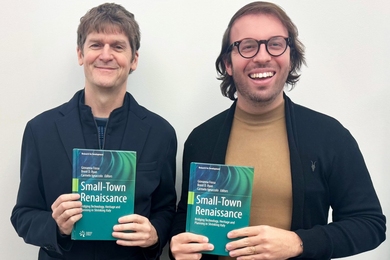CAMBRIDGE, Mass. -- Martin Deutsch, a Massachusetts Institute of Technology physicist from Vienna who fled fascism, worked on the Manhattan Project and later discovered an elemental form of matter, died Aug. 16 at his home in Cambridge, Mass., at the age of 85.
Deutsch recently had some heart problems, but the immediate cause of death has not been determined, the family said.
Suzanne Z. Deutsch, his wife of 63 years, said in a telephone interview, "There was nothing in life that he didn't want to understand. That was the hallmark of his life: understanding and teaching."
The crowning achievement of Deutsch's career came in 1951 at age 34, when he measured and confirmed the existence of positronium.
Positronium is a hydrogen-like atom without a nucleus. Its life exists entirely in a "dance of death" that lasts for as little as 1/10 of a billionth of a second. The properties of positronium corroborated the quantum theory of electrodynamics for a two-particle system.
Speaking of his MIT discovery at a scientific meeting at Brookhaven National Laboratory on Dec. 8, 1951, Deutsch explained that positronium is composed of a negative electron (negatron) and a positive electron (positron).
The New York Times account the next day stated, "Unlike negative electrons, which flash in a stroke of lightning or flow in a wire as a current of electricity, positrons have an evanescent life measured in millionths of a second. In the cosmic rays a negatron and a positron constitute a binary system, much like a double star, with the negatron and positron revolving around each other."
Professor Deutsch found there were two forms of positronium, a state of matter which was first theorized to exist by C.D. Anderson of Caltech in 1932. Parapositronium decays by annihilation--with a mean life of about 1/10 of a nanosecond, going into two equal photons (pulses of energy). Orthopositronium, with a mean life 10 times longer, annihilates into three photons.
"It was a spectacular production on Martin's part," said MIT Institute Professor of Physics Emeritus Francis Low, who worked with Deutsch on positronium experiments in MIT's Laboratory for Nuclear Science. Deutsch headed the laboratory from 1973-79 and was succeeded by Low.
Low, in a telephone interview, recalled his friend with affection. "Martin was a remarkably knowledgeable man, a firehose of information in the MIT tradition. He had a wide understanding of the scientific, social and political scene, had strong opinions about them and was always delighted to tell you about them."
Deutsch was born Jan. 29, 1917 into the intellectual ferment of World War I, Vienna, and a home where his parents, Felix and Helene Deutsch, were both doctors. "Everybody that came to our house had a doctorate of some sort," he wrote in a three-page autobiographical sketch in "Adventures in Experimental Physics." In an interview with the Boston Globe in 1998, he said, "I am, first of all, a product of my culture, which is the culture of Vienna Jews."
Before he was two, his mother, a professor in the psychiatry department at the University of Vienna, began analysis with Sigmund Freud. She became his devoted last pupil and Freud appointed her director of his Training Institute of the Vienna Psychoanalytic Society in 1923 when Martin was six.
"I was an only child," Martin Deutsch told the Boston Globe in a 1998 interview, "and my mother was sure I was a singular point in the universe."
In his autobiographical sketch, he wrote, "It was always taken for granted that I should become a scientist, although as late as my 12th year I seriously considered electrical engineering as an alternative."
At age 17, in February 1934, "I moved rather abruptly to Zurich, Switzerland, having participated in the resistance movement to the Fascist seizure of power in Austria." He graduated from a Swiss secondary school and completed one semester the following spring at the Swiss Federal Institute of Technology.
"In October 1935, I accompanied my mother to the United States, fully intending to return within a few weeks to continue my education in Europe. The Ethiopian war broke out while we were on the high seas and I decided to stay in America waiting for things to quiet down in Europe."
Deutsch's parents moved to Cambridge and became profoundly influential in psychiatry--his father in psychosomatic medicine and his mother with her publication of "The Psychology of Women" and "The Psychology of Motherhood."
Deutsch, brilliant in math and physics, enrolled at MIT and received permission to get a bachelor's degree in two years. He was drawn to the style of "the strongest experimental group" in the MIT physics department, the Spectroscopy Laboratory of Professor George Harrison.
"It was Harrison's junior course in atomic physics that had the greatest influence on me," he wrote. "The course was totally disorganized, and seemed to consist of a series of scientific anecdotes or vignettes. Somehow this style kindled my enthusiasm, and I still charge many of the insights into physics and the creative process which I acquired there to this influence.
"My fellow students were a hard-working lot, but a few of them were a good deal more than that," he wrote, recalling Richard Feynman, a member of the MIT Class of 1939. In 1965, Feynman won a Nobel Prize for work in quantum electrodynamics, a field advanced by Deutsch's discovery of positronium 14 years earlier.
Deutsch received a bachelor's degree in 1937 and the Ph.D. from MIT in 1941, completing in six years a course of study that typically takes 11.
"I have always been a hard worker, but a lazy learner," wrote Deutsch. "Therefore, I naturally gravitated to the relatively new field of nuclear physics where there was much to do but not yet too much to learn."
In the midst of his studies in 1939, he married Suzanne Zeitlan, a Boston native who had just graduated from Simmons College with a master's degree in social work.
Deutsch in 1941 was a German subject (because of Germany's takeover of Austria) and consequently an "enemy alien." He was also an Austrian citizen and an active antifascist. He taught and did research for two years at MIT while he underwent a security investigation to get clearance to work on the atomic bomb as part of the Manhattan Project in Los Alamos, N.M.
"It was a unique opportunity for a young man, two years after his Ph.D., to work with almost all the great men in the field--Bohr, Fermi, Bethe, Segr�, Oppenheimer and many others. I had the good fortune of working closely with Emilio Segr� and his group on problems of fission physics rather than weapons technology," he wrote.
Among those Los Alamos scientists was future MIT colleague Victor Weisskopf, who had attended the same high school as Deutsch in Vienna, graduating the year that Deutsch entered the school.
Regarding Weisskopf, Deutsch wrote, "Almost 20 years later, when I first met him in Los Alamos, he produced a photograph of the teacher who had told each of us that we would end in the gutter."
In 1946, Deutsch returned to MIT, where Weisskopf and Bruno Rossi had joined the physics faculty and Jerrold Zaccharias was building the Laboratory for Nuclear Science.
"The next five or six years were harvest years for me. Ideas that had germinated during the war years led to others, and somehow, it seems ... everything I touched turned to gold ... I find myself incredulous at the pace at which new results and new ideas came to fruition."
Among his students at the time was the late Henry Kendall, another MIT Institute Professor who won the Nobel Prize in 1990 for his co-discovery of the quark. Deutsch was responsible for recruiting to MIT another future Nobel Prize winner, Samuel Ting, who won the Nobel Prize for the J particle he discovered at the Laboratory for Nuclear Science while Deutsch was head of the lab.
"He had a great eye for talented scientists, and not a shred of envy in him," recalled Mrs. Deutsch, She read a letter that Deutsch, a self-styled control freak, wrote to a close friend in 1994, seven years after retiring from MIT.
"My attitude to prizes is peculiar, not clearly pathological but peculiar," Deutsch wrote. "I'm really glad that I did not get the Nobel Prize in 1956. It would have spoiled my life."
Reflecting about this attitude, he said he suddenly remembered an incident in the summer of 1923, when his mother was named director of Freud's institute and the family spent a summer at a Baltic resort. A sack-hopping race had been organized for the children.
"I was leading. I recall that I deliberately slowed down in order to come in second. The reasons for this action were quite complex but an oversimplified description could be that I did not want to give my mother the satisfaction of saying, 'My son, the sack race winner.'"
Deutsch is survived by his wife, who retired from Massachusetts General Hospital as a supervisor of social work, and two sons, L. Peter Deutsch of Menlo Park, Calif., and Nicholas Deutsch of New York City. A memorial service will be announced at a future date.






